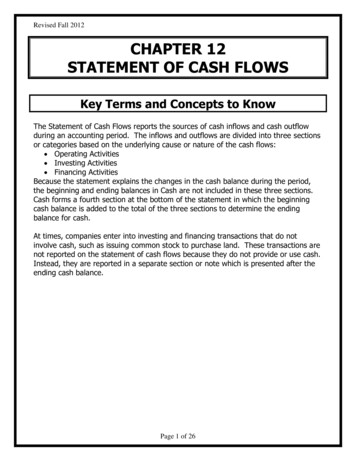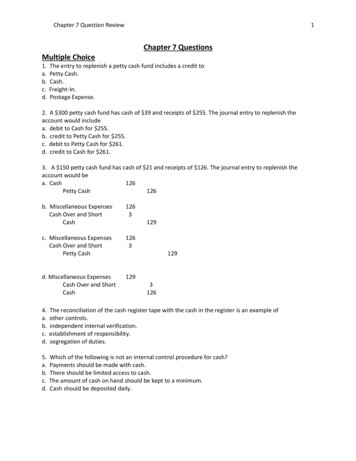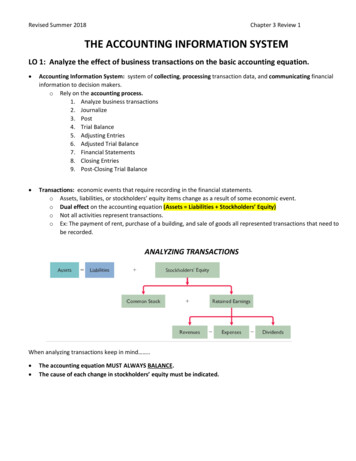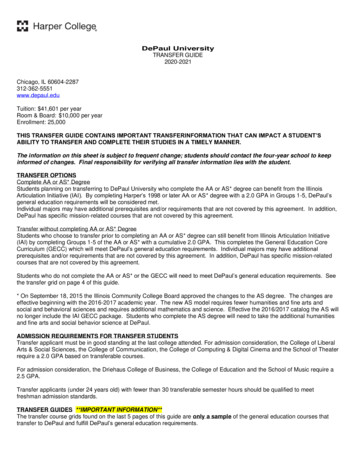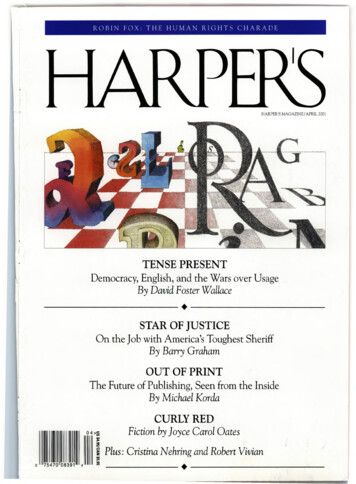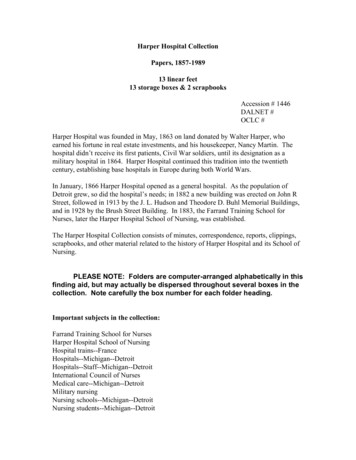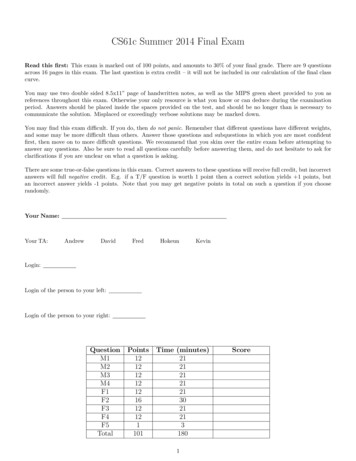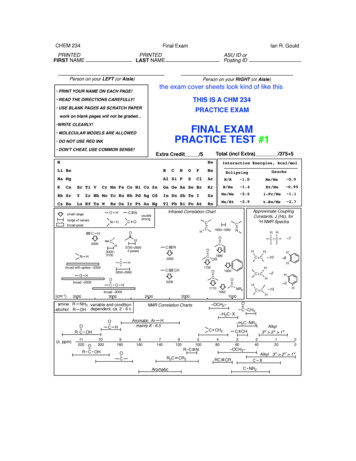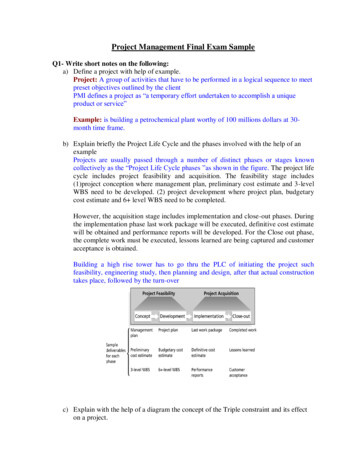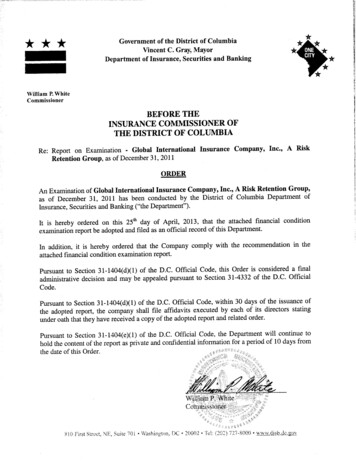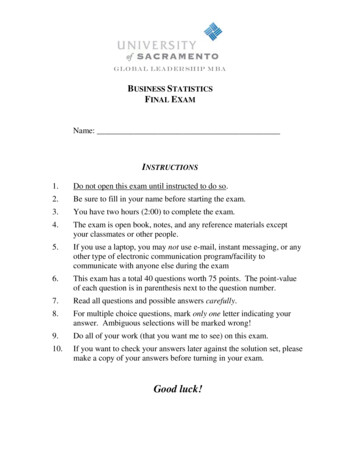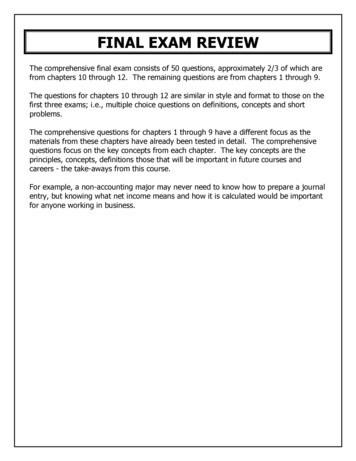
Transcription
FINAL EXAM REVIEWThe comprehensive final exam consists of 50 questions, approximately 2/3 of which arefrom chapters 10 through 12. The remaining questions are from chapters 1 through 9.The questions for chapters 10 through 12 are similar in style and format to those on thefirst three exams; i.e., multiple choice questions on definitions, concepts and shortproblems.The comprehensive questions for chapters 1 through 9 have a different focus as thematerials from these chapters have already been tested in detail. The comprehensivequestions focus on the key concepts from each chapter. The key concepts are theprinciples, concepts, definitions those that will be important in future courses andcareers - the take-aways from this course.For example, a non-accounting major may never need to know how to prepare a journalentry, but knowing what net income means and how it is calculated would be importantfor anyone working in business.
Practice Multiple Choice Questions1. Net Income isA. the amount the company earned after expenses and dividends are subtracted fromrevenue.B. the amount by which assets exceed expenses.C. the amount by which assets exceed liabilities.D. the amount by which revenues exceed expenses.2. Financial statements are most commonly prepared:A. daily.B. monthly, quarterly and annually.C. as needed.D. weekly.3. Which of the following is true?A. Companies can choose to end their fiscal year on any date they feel is most relevant.B. Companies must end their fiscal year on March 31, June 30, September 30, or December31.C. Companies can select any date except a holiday to end their fiscal year.D. Companies must end their fiscal year on December 31.4. Assets:A. represent the amounts earned by a company.B. must equal the liabilities of a company.C. must equal the stockholders' equity of the company.D. represent the resources owned by a company.5. Which of the following are the three basic elements of the balance sheet?A. assets, liabilities, and retained earnings.B. assets, liabilities, and contributed capital.C. assets, liabilities, and revenues.D. assets, liabilities, and stockholders' equity.6. Which of the following would not affect a company's net income?A. A change in the company's income taxes.B. Changing the selling price of a company's product.C. Paying a dividend to stockholders.D. Advertising a new product.
7. Which of the following would be reported on the income statement for 2013?A. Supplies that were purchased and used in 2012 but paid for in 2013.B. Dividends that were paid in 2013.C. Supplies that were purchased in 2012, but used in 2013.D. Accounts receivable as of December 31, 2013.8. A company began the year with Assets of 100,000, Liabilities of 20,000 and Stockholders'equity of 80,000. During the year Assets increased 55,000 and stockholders' equityincreased 20,000. What was the change in Liabilities for the year?A. Increase of 75,000B. Increase of 35,000C. Decrease of 75,000D. Decrease of 35,0009. Stockholders' equity isA. a liability of the business.B. an economic resource controlled by the business.C. the owners' claims on the business.D. the profit generated by the business.10. Which of the following statements regarding debits and credits is always true?A. Debits decrease accounts while credits increase them.B. The total value of all debits recorded in the ledger must equal the total value of all creditsrecorded in the ledger.C. The total value of all debits to a particular account must equal the total value of allcredits to that account.D. A debit balance of 500 in the cash account means that cash receipts exceeded cashpayments by 500.11. Which of the following would be listed as a current liability?A. Cash in the bankB. Notes payable due in two yearsC. SuppliesD. Accounts payable
12. Which one of the following statements regarding the accrual basis and cash basis ofaccounting is true?A. Using the accrual basis of accounting, if payment is received before delivery of a good orservice, revenue is recorded at the time the payment is received.B. Using the accrual basis of accounting, if payment is received after delivery of a good orservice, an asset is recorded at the time the good or service was delivered.C. Using the cash basis of accounting, if payment is received before delivery of a good orservice, net income is affected when goods or services are delivered.D. Using the cash basis, if payment is received after delivery of a good or service, unearnedrevenue is recorded.13. Which one of the following statements regarding the trial balance is true?A. A trial balance is included in the full set of external financial statements.B. If debits equal credits in the unadjusted trial balance, there are no errors in preparingand posting journal entries.C. The balances for each account reported on an unadjusted trial balance are taken fromthe ending balances of all the accounts in the general ledger.D. GAAP allows companies to use either the cash basis or the accrual basis of accounting.14. Your company orders and receives supplies in January, pays for them in February, providesservices that use those goods up in March and is paid by customers in April. Using theaccrual basis of accounting:A. Expenses are recorded in February and revenues are recorded in April.B. Expenses are recorded in February and revenues are recorded in March.C. Expenses and revenues are recorded in March.D. Expenses are recorded in January and revenues are recorded in April.E15. The unadjusted trial balance:A. Is a preliminary financial statement for external and internal users.B. Generally lists account names in alphabetical order.C. Is created to determine that total debits equal total credits.D. Indicates whether or not errors were made in recording transactions.16. Which of the following is an error that would cause the trial balance to be out of balance?A. A journal entry was posted as a debit to Cash for 525 and a credit to AccountsReceivable for 552.B. A journal entry was posted as a debit to Cash and a credit to Sales Revenue when thecompany received a 400 payment from a customer on account.C. A purchase of supplies on account for 100 was posted as a debit to supplies for 10 anda credit to accounts payable for 10.D. A 350 transaction was not recorded at all.
17. Which of the following accounts does not have a normal debit balance?A. Wages ExpenseB. Service RevenueC. Accounts ReceivableD. Cash18. Which of the following statements regarding adjusting entries is not true?A. Adjustments are needed to ensure that the accounting system includes all of therevenues and expenses of the period.B. Adjustments help to ensure the related accounts on the balance sheet and incomestatement are up to date and complete.C. Adjusting entries often affect the cash account.D. Adjusting entries generally include one balance sheet and one income statementaccount.19. Which of the following statements regarding the trial balance is correct?A. The adjusted trial balance is prepared after the financial statements to verify that thenumbers are accurate.B. The primary purpose of the post-closing trial balance is to see whether revenues aregreater than expenses.C. The adjusted trial balance is a check that the accounting records are still in balance afterposting all adjustments to the accounts.D. The post-closing trial balance debit column total is the amount to be shown as TotalAssets on the Balance Sheet.20. Which of the following statements regarding timing issues associated with the closingentries is true?A. Closing entries are recorded at the end of each reporting period which could be monthly,quarterly or annually.B. After closing entries are posted, the balances of the income statement accounts will bezero.C. Closing entries are made to zero out the balances of the permanent accounts on thebalance sheet.D. After closing entries are posted, the only temporary account with a balance is theDividends Declared account.
21. One major difference between deferral and accrual adjustments is:A. Deferral adjustments involve previously recorded transactions and accruals involvepreviously unrecorded events.B. Deferral adjustments are made after taxes and accrual adjustments are made beforetaxes.C. Deferral adjustments are made annually and accrual adjustments are made monthly.D. Deferral adjustments are influenced by estimates of future events and accrualadjustments are not.22. Which of these accounts would normally not be affected by an adjustment?A. Supplies.B. Revenues.C. Expenses.D. Cash.23. Contra-accounts:A. Are used to increase the original value of the account they offset.B. Always appear in the same column of the trial balance as the account they offset.C. Are used to decrease the original value of the account they offset.D. Reduce the related asset to its fair value.24. Which of the following will happen if the accrual adjustment entry is not made to recordexpenses incurred but not yet recorded?A. Both expenses and liabilities will be overstated.B. Both expenses and liabilities will be understated.C. Expenses will be understated and liabilities will be overstated.D. Expenses will be overstated and liabilities will be understated.25. Which of the following statements regarding inventory counts is not true?A. Companies need to perform a physical count of their inventory at least yearly regardlessof which inventory system is being used.B. A perpetual inventory system does not require a physical count during the accountingperiod to determine cost of goods sold.C. In a perpetual inventory system, the inventory count is compared to the inventoryaccount balance to reveal shrinkage.D. If a company uses a perpetual inventory system and the inventory count at the end ofthe accounting period is greater than the balance in the inventory ledger account, theremust have been shrinkage.
26. Which one of the following statements regarding sales discounts is true?A. If a company offers a discount to encourage prompt payment and the discount is taken,the discount reduces the amount of Net Sales.B. Credit terms of "2/10, n/30" mean that if payment is made in two days, a 10% discountmay be taken; if not paid within two days, the full invoice price will be due in thirty days.C. The terms "sales discounts" and "sales credits" are used interchangeably by a company.D. Sales Discounts is an expense account.27. When a customer returns for credit a defective product it had purchased, the seller wouldrecord the transaction using which of the following accounts?A. Purchase Returns and AllowancesB. Sales Returns and AllowancesC. SalesD. Sales Discounts28. Which of the following items appearing on a bank reconciliation would require journalentries to bring the cash account up to date?A. Deposits in transit.B. Checks from customers returned as NSF.C. Outstanding checks.D. An error made by the bank in recording a deposit.29. When preparing a bank reconciliation, interest received from the bank is:A. Added the amount of interest to the balance per bank.B. Deducted the amount of interest from the balance per books.C. Added the amount of interest to the balance per books.D. Deducted the amount of interest from the balance per bank.30. The Tuck Shop began the current month with inventory costing 10,000, then purchasedinventory at a cost of 35,000. The perpetual inventory system indicates that inventorycosting 30,000 was sold during the month for 40,000. If an inventory count shows thatinventory costing 14,500 is actually on hand at month-end, what amount of shrinkageoccurred during the month?A. 500.B. 5,000.C. 14,495.D. 15,000.
31. A company sells goods at a selling price of 20,000. The cost of the goods is 15,000.Under a perpetual inventory system the journal entries to record the sale will include:A. 15,000 will be debited to Inventory and 15,000 will be credited to Sales.B. 15,000 will be debited to Cost of goods sold and 15,000 will be credited to Inventory.C. 15,000 will be credited to Inventory and 15,000 will be credited to Sales.D. 15,000 will be debited to Cost of goods sold and 15,000 will be credited to Sales.32. When a company collects from a customer who pays within the discount period, thecompany:A. Debits a contra-revenue account.B. Debits a liability account.C. Credits a liability account.D. Debits a revenue account.33. When goods are sold to a customer with credit terms of 2/15, n/30, the customer will:A. Receive a 15% discount if they pay within 2 days.B. Receive a 2% discount if they pay 15% of the amount due within 30 days.C. Receive a 15% discount if they pay within 30 days.D. Receive a 2% discount if they pay within 15 days.34. The gross profit equation is:A. (Sales Sales returns & allowances) - Cost of goods sold Gross profitB. (Sales Sales discounts) - Cost of goods sold Gross profitC. (Sales - Sales returns & allowances - Sales discounts) - Cost of goods sold Gross profitD. (Sales - Sales returns & allowances - Sales discounts) Cost of goods sold Gross profit35. The principles of internal control include which of the following?A. Use only computerized systems.B. Establish responsibilities.C. Maintain perpetual inventory records.D. Eliminate fraud.36. On a bank reconciliation, the amount of an unrecorded bank service charge isA. Added to the bank balance of cash.B. Added to the company's balance of cash.C. Deducted from the bank balance of cash.D. Deducted from the company's balance of cash.
37. Merchandise shipped FOB shipping point on the last day of the year should be included in:A. The inventory balance of the seller.B. The inventory balance of the buyer.C. Neither the inventory balance of the buyer or the seller.D. Both the inventory balance of the buyer and the seller.38. Cash equivalents include which of the following:A. 30-day bank certificates of deposit.B. Petty cash.C. 6-month U.S. treasury bills.D. Savings account balances.39. Which of the following statements regarding inventory calculations is true?A. Beginning inventory net purchases - ending inventory cost of goods sold.B. Goods available for sale ending inventory cost of goods sold.C. Beginning inventory net purchases - ending inventory goods available for sale.D. Goods available for sale cost of goods sold ending inventory.40. Which of the following statements regarding inventory costing methods is true?A. The LIFO method assumes that the costs for the newest goods (the last ones in) areused first and the older costs are left in ending inventory.B. During a period of rising prices, LIFO results in a higher income tax expense than doesFIFO.C. International Financial Reporting Standards (IFRS) allow the use of LIFO but not FIFO.D. In the U.S., if a company uses LIFO on the income tax return, it may use a differentmethod for financial reporting.41. Which of the following statements regarding the calculations used for the weighted averageinventory costing method is true?A. Under the weighted average cost method, if the goods in inventory were purchased atthree different prices, the three different prices would be added and then divided bythree to find the weighted average cost per unit.B. When the weighted average inventory costing method is used, ending inventory and costof goods sold are calculated using different costs per unit.C. There is no difference in the calculations under the weighted average method whether aperpetual or periodic inventory system is used.D. The weighted-average method will produce an inventory cost which is between theresults of FIFO and LIFO inventory costing methods.
42. Which of the following statements regarding the lower of cost or market rule is not true?A. The lower of cost or market rule sometimes causes the book value of inventory to bewritten down below cost, but will never cause the book value of inventory to beincreased above cost.B. The amount of inventory write-down is an expense which most companies report as costof goods sold.C. Lower of cost or market is an inventory cost method used to determine cost of goodssold and ending inventory.D. The lower of cost or market rule is based on the conservatism concept.43. The specific identification method would probably be most appropriate for which of thefollowing goods?A. Boxes of brass 4-inch drywall screws at Home Depot.B. Bottles of suntan lotion in Wal-Mart's central warehouse.C. Sets of tires at the Goodyear plant.D. Diamond necklaces at a Tiffany & Co. jewelry store.44. Which inventory costing method generally results in the most recent costs being assigned toending inventory?A. LIFO.B. FIFO.C. Weighted average cost.D. Simple average cost.45. For a merchandiser, inventory turnover refers to how many times:A. During the period the company replaces its raw materials inventory.B. The company buys and sells its inventory of goods.C. The company produces and delivers its inventory of goods to customers.D. The company orders merchandise.46. A 15,000 overstatement of the 2014 ending inventory was discovered after the financialstatements for the year were prepared. How would that inventory error impact the 2014financial statements?A. Current assets were overstated and net income was understated.B. Current assets were understated and net income was understated.C. Current assets were overstated and net income was overstated.D. Current assets were understated and net income was overstated.
47. In applying the lower of cost or market method to inventory, market is defined asA. Historical cost.B. Current replacement cost.C. Current sales price.D. Weighted-average cost.48. Which of the following statements regarding the allowance for doubtful accounts is true?A. Under the aging of accounts receivable method, bad debt expense is calculated and thenadded to the beginning balance in the allowance for doubtful accounts.B. The allowance for doubtful accounts is a contra-revenue account.C. The allowance for doubtful accounts is credited when a specific write-off is recorded.D. The allowance for doubtful accounts has a normal credit balance.49. Which of the following statements regarding the recording of interest on notes receivable istrue?A. Interest on notes receivable is recorded as revenue only when the cash is received.B. When a company receives an interest payment on a note, the entire payment is debitedto interest receivable.C. Interest on notes receivable is recognized when it is earned which is not necessarilywhen the interest is received in cash.D. Interest earned but not yet received must be recorded in an adjusting entry whichincludes a debit to interest revenue.50. An allowance for doubtful accounts is a contra-account that offsets:A. bad debt expense.B. cash.C. net income.D. accounts receivable.51. The Grass is Greener Corporation provides 6,000 worth of lawn care on account during themonth. Experience suggests that about 2% of net credit sales will not be collected. Torecord the potential bad debts, The Grass is Greener Corporation would:A. debit Accounts Receivable and credit Allowance for Doubtful Accounts for 120.B. debit Allowance for Doubtful Accounts and credit Bad Debt Expense for 120.C. debit Bad Debt Expense and credit Allowance for Doubtful Accounts for 120.D. debit Bad Debt Expense and credit Accounts Receivable for 120.
52. The Grass is Greener Corporation uses the allowance method and learns that a customerwho owes 350 has gone bankrupt and payment will not be made. The Grass is GreenerCorporation should:A. debit Bad Debt Expense and credit Accounts Receivable for 350.B. debit the Allowance for Doubtful Accounts and credit Accounts Receivable for 350.C. debit Bad Debt Expense and credit Cash for 350.D. debit Accounts Receivable and credit Bad Debt Expense for 350.53. On the balance sheet, the allowance for doubtful accounts:A. is included in current liabilities.B. increases the reported net value of accounts receivable.C. appears under the heading "Other Assets."D
Using the accrual basis of accounting, if payment is received after delivery of a good or service, an asset is recorded at the time the good or service was delivered. C. Using the cash basis of accounting, if payment is received before delivery of a good or service, net
